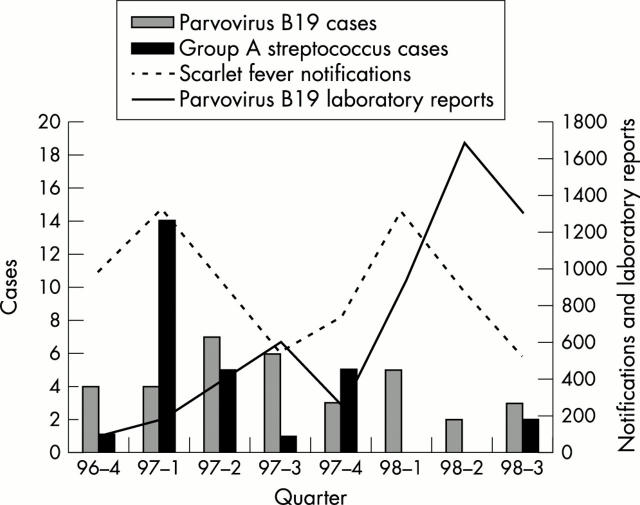Abstract
Aims: To determine the causes of morbilliform rash and fever in a population with high vaccination coverage for measles and rubella.
Methods: Comprehensive laboratory investigation additional to routine oral fluid testing of children presenting to primary care physicians in East Anglia, England.
Results: Laboratory confirmation of infection was obtained in 93 (48%) of 195 children: parvovirus B19 in 34 (17%); group A streptococcus in 30 (15%); human herpesvirus type 6 in 11 (6%); enterovirus in nine (5%); adenovirus in seven (4%); and group C streptococcus in six (3%) (four individuals tested positive for two agents). None had measles or rubella.
Conclusions: Oral fluid testing to cover infections additional to measles and rubella aids clinical management and is likely to maintain uptake of testing, which is essential for measles and rubella surveillance in highly immunised low incidence populations.
Full Text
The Full Text of this article is available as a PDF (132.2 KB).
Figure 1 .
Number of study cases of parvovirus B19 and GAS by date of onset, parvovirus B19 laboratory reports, and scarlet fever notifications by quarter, 1996–4 to 1998–3.
Selected References
These references are in PubMed. This may not be the complete list of references from this article.
- Boom R., Sol C. J., Salimans M. M., Jansen C. L., Wertheim-van Dillen P. M., van der Noordaa J. Rapid and simple method for purification of nucleic acids. J Clin Microbiol. 1990 Mar;28(3):495–503. doi: 10.1128/jcm.28.3.495-503.1990. [DOI] [PMC free article] [PubMed] [Google Scholar]
- Brown D. W., Ramsay M. E., Richards A. F., Miller E. Salivary diagnosis of measles: a study of notified cases in the United Kingdom, 1991-3. BMJ. 1994 Apr 16;308(6935):1015–1017. doi: 10.1136/bmj.308.6935.1015. [DOI] [PMC free article] [PubMed] [Google Scholar]
- Cherry J. D. Contemporary infectious exanthems. Clin Infect Dis. 1993 Feb;16(2):199–205. doi: 10.1093/clind/16.2.199. [DOI] [PubMed] [Google Scholar]
- Cohen B. J. Detection of parvovirus B19-specific IgM by antibody capture radioimmunoassay. J Virol Methods. 1997 Jun;66(1):1–4. doi: 10.1016/s0166-0934(97)00048-7. [DOI] [PubMed] [Google Scholar]
- Davidkin I., Valle M., Peltola H., Hovi T., Paunio M., Roivainen M., Linnavuori K., Jokinen S., Leinikki P. Etiology of measles- and rubella-like illnesses in measles, mumps, and rubella-vaccinated children. J Infect Dis. 1998 Dec;178(6):1567–1570. doi: 10.1086/314513. [DOI] [PubMed] [Google Scholar]
- Fox J. P., Hall C. E., Cooney M. K. The Seattle Virus Watch. VII. Observations of adenovirus infections. Am J Epidemiol. 1977 Apr;105(4):362–386. doi: 10.1093/oxfordjournals.aje.a112394. [DOI] [PubMed] [Google Scholar]
- Gay N. J., Hesketh L. M., Cohen B. J., Rush M., Bates C., Morgan-Capner P., Miller E. Age specific antibody prevalence to parvovirus B19: how many women are infected in pregnancy? Commun Dis Rep CDR Rev. 1994 Aug 19;4(9):R104–R107. [PubMed] [Google Scholar]
- Miller E. The new measles campaign. BMJ. 1994 Oct 29;309(6962):1102–1103. doi: 10.1136/bmj.309.6962.1102. [DOI] [PMC free article] [PubMed] [Google Scholar]
- Perry K. R., Brown D. W., Parry J. V., Panday S., Pipkin C., Richards A. Detection of measles, mumps, and rubella antibodies in saliva using antibody capture radioimmunoassay. J Med Virol. 1993 Jul;40(3):235–240. doi: 10.1002/jmv.1890400312. [DOI] [PubMed] [Google Scholar]
- Ramsay M. E., Brugha R., Brown D. W., Cohen B. J., Miller E. Salivary diagnosis of rubella: a study of notified cases in the United Kingdom, 1991-4. Epidemiol Infect. 1998 Jun;120(3):315–319. doi: 10.1017/s0950268898008838. [DOI] [PMC free article] [PubMed] [Google Scholar]
- Ramsay M., Brugha R., Brown D. Surveillance of measles in England and Wales: implications of a national saliva testing programme. Bull World Health Organ. 1997;75(6):515–521. [PMC free article] [PubMed] [Google Scholar]
- Ramsay M., Gay N., Miller E., Rush M., White J., Morgan-Capner P., Brown D. The epidemiology of measles in England and Wales: rationale for the 1994 national vaccination campaign. Commun Dis Rep CDR Rev. 1994 Nov 11;4(12):R141–R146. [PubMed] [Google Scholar]
- Tait D. R., Ward K. N., Brown D. W., Miller E. Exanthem subitum (roseola infantum) misdiagnosed as measles or rubella [corrected]. BMJ. 1996 Jan 13;312(7023):101–102. doi: 10.1136/bmj.312.7023.101. [DOI] [PMC free article] [PubMed] [Google Scholar]
- Ward K. N., Gray J. J., Fotheringham M. W., Sheldon M. J. IgG antibodies to human herpesvirus-6 in young children: changes in avidity of antibody correlate with time after infection. J Med Virol. 1993 Feb;39(2):131–138. doi: 10.1002/jmv.1890390209. [DOI] [PubMed] [Google Scholar]
- Yalcin S., Karpuzoglu T., Suleymanlar G., Mutlu G., Mukai T., Yamamoto T., Isegawa Y., Yamanishi K. Human herpesvirus 6 and human herpesvirus 7 infections in renal transplant recipients and healthy adults in Turkey. Arch Virol. 1994;136(1-2):183–190. doi: 10.1007/BF01538827. [DOI] [PubMed] [Google Scholar]



